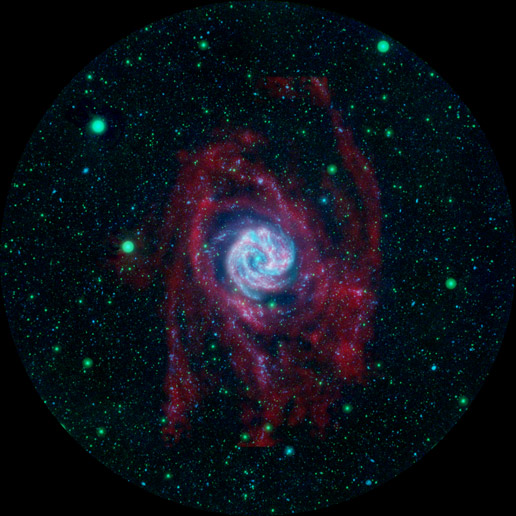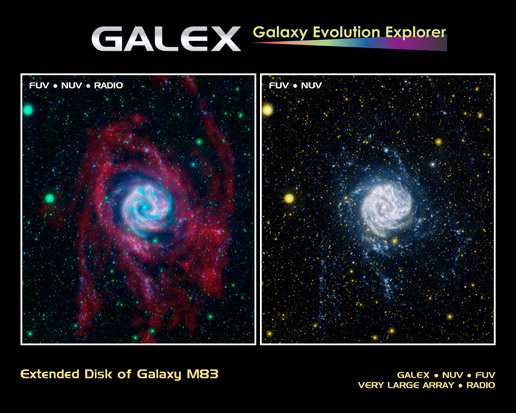This just in from the pretty pictures department at NASA. NASA’s Galaxy Evolution Explorer (GALEX) shows young stars sprouting up in a relatively desolate region of space more than 100,000 light-years from the galaxy’s bustling center. This striking image is a composite of ultraviolet data from GALEX and radio data from the Very Large Array in New Mexico, and shows the Southern Pinwheel galaxy, also known simply as M83. “It is absolutely stunning that we find such an enormous number of young stars up to 140,000 light-years away from the center of M83,” said Frank Bigiel, lead investigator of the new Galaxy Evolution Explorer observations. For comparison, the diameter of M83 is only 40,000 light-years across.
M83 is located 15 million light-years away in the southern constellation Hydra. The ultraviolet image was taken by NASA’s Galaxy Evolution Explorer between March 15 and May 20, 2007.
In this view, the main spiral, or stellar, disk of M83 looks like a pink and blue pinwheel, while its outer arms appear to flap away from the galaxy like giant red streamers. It is within these so-called extended galaxy arms that, to the surprise of astronomers, new stars are forming.
This side-by-side comparison shows the Southern Pinwheel galaxy, or M83, as seen in ultraviolet light (right) and at both ultraviolet and radio wavelengths (left). While the radio data highlight the galaxy’s long, octopus-like arms stretching far beyond its main spiral disk (red), the ultraviolet data reveal clusters of baby stars (blue) within the extended arms.
Astronomers speculate that the young stars seen far out in M83 could have formed under conditions resembling those of the early universe, a time when space was not yet enriched with dust and heavier elements.
“Even with today’s most powerful telescopes, it is extremely difficult to study the first generation of star formation. These new observations provide a unique opportunity to study how early generation stars might have formed,” said co-investigator Mark Seibert of the Observatories of the Carnegie Institution of Washington in Pasadena.
Original News Source: NASA GALEX press release



We can see original space objects within 150 million kilometer. Ahade of it everything is mere image into space mirror. It can not explain in short. . Therefore it invites to visit http://www.spacemirrormystery.com to know the original truth